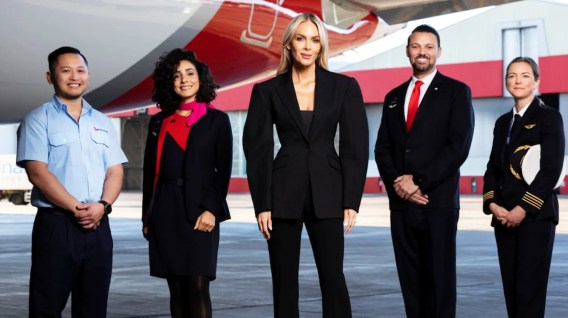Qantas misses runway with Rebecca Vallance comms
Yesterday’s announcement of Qantas appointing prominent female fashion designer Rebecca Vallance to create new uniforms should, in theory, be cause for celebration. Supporting Australian design talent and refreshing a brand’s visual identity are typically positive moves for any major corporation.
But timing, as they say, is everything. PR crisis communications expert Sally Branson explains.

Rebecca Vallance and Qantas staff
This uniform redesign was first floated months ago, right in the heart of one of Qantas’s most significant reputation crises.
Now, barely three weeks after the airline was ordered to pay a staggering $90 million industrial relations payout, we’re seeing this soft PR push resurface.
This seems to be a disconnect from brand polish and core business.
Here’s the challenge facing Qantas: while they’re announcing designer uniforms, everyday consumers are asking fundamental value questions about service delivery. Will my flight be on time? Why do airfares keep climbing? When will the core service issues be resolved? Will be bags be at the same destination I am? Is there any value in a points program?


Dear Sally
FYI: This is a delayed project, nothing new. And, if you had bothered to ask the staff, it’s one of the most uncomfortable uniforms they’ve ever worn; my daughter will vouch for that and can’t wait to wear a more practical outfit! Designed to look great on a Victoria’s Secret model, the fabric quality and sizing has diminished over the years. Australia’s largest bank launched a new uniform in 2019 and, in the same time period, it closed many of its branches, removed ATMs, made banking harder for the elderly and rural communities and made record profits. Why aren’t you complaining about them?
Qantas has had this current uniform since 2013 and actually delayed any move to a new uniform due to Covid. There was a perfect opportunity to coincide with its 100th birthday but a new uniform was still delayed, as it should have been.. but you didn’t bother to find out or mention that. Have you thought about weather, sick leave, aircraft maintenance and other reasons for your flight changes? It’s an airline, get real and get some perspective. You’ve obviously never taken public transport in Victoria!
Your observations on perceptions of the broader public are correct. But I would suggest there’s little thought given to a new uniform by most who fly the airline fewer than a couple of times per year.
However for the engaged (and far more lucrative) regular market, these travelers have already experienced the difference of the new post-Joyce Qantas, and the significant improvements which have been made across the board. For them, the problems of the past aren’t a part of their world, and this (coupled with the hype of a bunch of new planes) is just another step in the refresh and improvement of the brand.
Come On!! Why does everything that Qantas does result in negative stories. AJ has gone!! What he did to Qantas was just appalling and outrageous!! I know that personally. I worked for Qantas for 38 yrs. Joyce was a numbers man concerned in the bottom line irrespective of the consumer or the staff!! Yes we all agree here. But it time to give them some space and see what Vanessa does here. The staff need a break and I know after going from the Pucci to the Grant Uniform and all others in between – YSL, George and Harry, Morrissey, a new uniform always had a positive impact on all the staff!! And that is needed by them all having to be the front of the company and be the face that the public complained to constantly (with every right to do so from AJ’s actions), it’s time to give them all a break! Be nice, be respectiveful and be somewhat forgiving. Far worse things are going on in the world and within our country too!
And they top it off by announcing a $3.8 million bonus for the previous CEO just after this was published. Unbelievable!
As a longstanding QANTAS Platinum flyer I have seen the slow. And painful deterioration of their service delivery!
It seems no one in QANTAS is accountable and there is no cost impact to Qantas when they constantly delay and even cancel flights for “technical reasons“., in fact we know they often do it to save money!
They need to have a cost impact to QANTAS for these constant delays and regular cancellations! I have for sometime suggested that when a Flight is delayed more than 15 minutes they should gift their guests status credits or FF points to the value of the Flight. If it is delayed for an hour, they do it again and for every hour thereafter they do it again! If the flight is cancelled, 5 times the status credits!
Let that land on somebody’s KPI and we might see QANTAS once again reflecting the Spirit of Australia!
Congratulations.
Incredibly well written.
I’m a QF Frequent Flyer who has had missing bag on QANTAS International flights on 4 occasions.
It took QANTAS 10 days to respond to lost bags in the last occasion.
I couldn’t give brads razor what cabin crew wear. Or how long their beard is.
I want service. It’s not happening.
QANTAS prices are frequently double those of International Airlines.